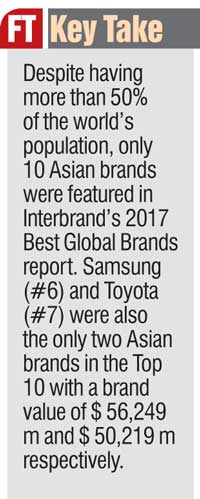Friday Jan 09, 2026
Friday Jan 09, 2026
Tuesday, 3 April 2018 00:00 - - {{hitsCtrl.values.hits}}

For the first time, Interbrand has released a comprehensive analysis of the best brands in Asia, compiling insights from Best Japan Brands, Best China Brands, Best Korea Brands and Best India Brands, while also examining how brands are growing within Australia and the markets of Southeast Asia.
Despite having more than 50% of the world’s population, only 10 Asian brands were featured in Interbrand’s 2017 Best Global Brands report. Samsung (#6) and Toyota (#7) were also the only two Asian brands in the Top 10 with a brand value of $ 56,249 m and $ 50,219 m respectively.
Interbrand’s Best Asian Brand study assesses the growth of each major Asian market, as determined by Interbrand data conducted over the past five years, and indicates the onset of a period of accelerating change, or a new age. An over-riding theme centres around changing customer behaviour, digitisation, and how brands are responding, or not, to these changes.
“Asia’s marketplace is vast and varied, populated by different cultures, religions, and societies,” says Jonathan Bernstein, Managing Director, Interbrand Singapore. “Brands and businesses seeking success in more than one country in the region need to view the region not as a colourless supermarket, but as multiple bazaars – in varying degrees of development, in close proximity, and with fluid entryways to one another. Brands that understand this perspective have three things in common: a resonant brand promise, go-to-market strategies for different markets, and experiences which are tangible, meaningful, and relevant to target audiences. Starbucks is a case in point. Its sanctity as a “third place” and global appeal as a credible, aspirational coffee source remains intact across Asia. At the same time – from Yangon to Singapore – Starbucks adapts its food selection and store interiors to reflect its locale, thereby rooting itself in each of the markets it operates in.”
According to Bernstein, the challenge for Asian brands continues to be “to communicate a single, unifying purpose that employees and customers across demographics can rally around, one that goes beyond being first-in-market. Brands like Samsung and Toyota that Interbrand has built have not only been able to maintain consistency and clarity for their brands amid incredible market and consumer shifts, but also deliver meaningful, relevant experiences for customers across Asia’s complex landscape.”
Both brands are also highly aware that without creating personal impact, innovation is irrelevant, Bernstein said. “They have used this to guide their technology advancements. For example, Samsung’s people-centric approach to innovation adapts to the customer’s life rather than the other way around. Because of this, it is able to create not only relevant products but ones that are rewarding for customers. Samsung has also communicated its purpose to not only improve the lives of its customers but to chart the course of the future.”
Interbrand Chief Executive Officer for Asia-Pacific, Stuart Green, says that while the limited presence of Asian brands in global rankings is due to factors such as a “copy-cat” mentality and a focus on low-cost manufacturing, customer expectations are also changing and opportunities for Asian brands are growing due to rapid technological advancement and demographic shifts. Green believes that tech companies more than most are leading the way in this respect by leveraging technology tools in ways that are relevant to consumers, to drive choice, loyalty, and ultimately better business performance.
“Each market in the Asia region has its own unique way of conducting business and its own unique cultural characteristics,” says Green. “Brands in Asia will win and engage better with customers if they use big data and insights-driven marketing to create value for their customers and launch innovative products and services.”
Brand purposing has traditionally been neglected by Indian brands, says Ashish Mishra, Managing Director, Interbrand India. “Our research into Indian brands across industries – including conversations with leading CMOs – reveals the top reasons for this lack of engagement. The Indian market is constantly expanding and extremely competitive so building presence and salience often takes centre stage. Indian marketers are often too preoccupied with retail challenges to worry about engaging with consumers through a unifying purpose and resonant promise. Assuming a brand overcomes cost and infrastructure hurdles, the question then becomes – who do you engage with? There are multiple India’s – many cultures, languages, and urban-rural populations that make it difficult to create compelling and relevant engagement.”
Despite these challenges, Mishra emphasises the importance of “hero categories” where brands are expected to design their experiences around customers through purposing and engagement. “The best bets for engagement strategies lie in the sectors in which customer segments are of higher value such as luxury goods and services, HNI wealth management, high-end hospitality, and gems and jewellery. The upward mobility of consumers will eventually push this practice into all sectors making “connection” the source of growth for businesses and brands throughout India.”
In 2017, Interbrand included Sri Lanka in its global Best Brands listing and valuated the Top 20 brands in the country. “Brand Strength assessments by the Interbrand London office found consistently low engagement scores with leading brands scoring an average 4.5 out of 10,” says Michel Nugawela, Interbrand Sri Lanka Partner.
“Culturally this is a major challenge for Sri Lankan businesses. Few understand the need to engage with stakeholders at a deeper level and over a sustained period of time, and fewer still know how to go about it. A key issue for many of the larger, conglomerate businesses also remains the sheer extent of their diversification, making it very difficult for them to define and express a clear brand definition in the first place.”
According to Nugawela, “A more fundamental issue is a lack of purpose beyond the desire to be “number one” or “beating the competition.” Being first-in-market may be important, but it is only of interest to a small number of people inside the organisation. The challenge is to clarify a purpose around doing something of direct benefit to customers or the world at large. Once this is done, Sri Lankan businesses must then keep customers engaged by discarding rigid models, hierarchies, silos, and processes that are themselves not customer-centric. New business models will need to be more organic, transparent, and even porous as the interactions between brand owners and their customers evolves ever more.”
Interbrand’s Best Asian Brands study also includes reports by Masahito Namiki, CEO, Interbrand Japan; Ji Hun Moon, CEO Interbrand Korea; Warren Wang, CEO Interbrand China; and Nathan Birch, CEO Interbrand Australia.